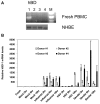Modulation of human beta-defensin-1 (hBD-1) in plasmacytoid dendritic cells (PDC), monocytes, and epithelial cells by influenza virus, Herpes simplex virus, and Sendai virus and its possible role in innate immunity
- PMID: 21551252
- PMCID: PMC3133436
- DOI: 10.1189/jlb.0209079
Modulation of human beta-defensin-1 (hBD-1) in plasmacytoid dendritic cells (PDC), monocytes, and epithelial cells by influenza virus, Herpes simplex virus, and Sendai virus and its possible role in innate immunity
Abstract
hBD comprise a family of antimicrobial peptides that plays a role in bridging the innate and adaptive immune responses to infection. The expression of hBD-2 increases upon stimulation of numerous cell types with LPS and proinflammatory cytokines. In contrast, hBD-1 remains constitutively expressed in most cells in spite of cytokine or LPS stimulation; however, its presence in human PDC suggests it plays a role in viral host defense. To examine this, we characterized the expression of hBD-1 in innate immune cells in response to viral challenge. PDC and monocytes increased production of hBD-1 peptide and mRNA as early as 2 h following infection of purified cells and PBMCs with PR8, HSV-1, and Sendai virus. However, treatment of primary NHBE cells with influenza resulted in a 50% decrease in hBD-1 mRNA levels, as measured by qRT-PCR at 3 h following infection. A similar inhibition occurred with HSV-1 challenge of human gingival epithelial cells. Studies with HSV-1 showed that replication occurred in epithelial cells but not in PDC. Together, these results suggest that hBD-1 may play a role in preventing viral replication in immune cells. To test this, we infected C57BL/6 WT mice and mBD-1((-/-)) mice with mouse-adapted HK18 (300 PFU/mouse). mBD-1((-/-)) mice lost weight earlier and died sooner than WT mice (P=0.0276), suggesting that BD-1 plays a role in early innate immune responses against influenza in vivo. However, lung virus titers were equal between the two mouse strains. Histopathology showed a greater inflammatory influx in the lungs of mBD-1((-/-)) mice at Day 3 postinfection compared with WT C57BL/6 mice. The results suggest that BD-1 protects mice from influenza pathogenesis with a mechanism other than inhibition of viral replication.
Figures






Similar articles
-
Modulation of Human β-Defensin-1 Production by Viruses.Viruses. 2017 Jun 21;9(6):153. doi: 10.3390/v9060153. Viruses. 2017. PMID: 28635669 Free PMC article. Review.
-
Replication-dependent potent IFN-alpha induction in human plasmacytoid dendritic cells by a single-stranded RNA virus.J Immunol. 2004 Nov 15;173(10):5935-43. doi: 10.4049/jimmunol.173.10.5935. J Immunol. 2004. PMID: 15528327
-
Antimicrobial peptides alter early immune response to influenza A virus infection in C57BL/6 mice.Antiviral Res. 2016 Sep;133:208-17. doi: 10.1016/j.antiviral.2016.08.013. Epub 2016 Aug 13. Antiviral Res. 2016. PMID: 27531368 Free PMC article.
-
Modulation of human beta-defensin-2 transcription in pulmonary epithelial cells by lipopolysaccharide-stimulated mononuclear phagocytes via proinflammatory cytokine production.J Immunol. 2003 Apr 15;170(8):4226-36. doi: 10.4049/jimmunol.170.8.4226. J Immunol. 2003. PMID: 12682256
-
Antiviral mechanisms of human defensins.J Mol Biol. 2013 Dec 13;425(24):4965-80. doi: 10.1016/j.jmb.2013.09.038. Epub 2013 Oct 2. J Mol Biol. 2013. PMID: 24095897 Free PMC article. Review.
Cited by
-
Antiviral and Immunomodulatory Properties of Antimicrobial Peptides Produced by Human Keratinocytes.Front Microbiol. 2020 Jun 3;11:1155. doi: 10.3389/fmicb.2020.01155. eCollection 2020. Front Microbiol. 2020. PMID: 32582097 Free PMC article. Review.
-
Host Combats IBDV Infection at Both Protein and RNA Levels.Viruses. 2022 Oct 21;14(10):2309. doi: 10.3390/v14102309. Viruses. 2022. PMID: 36298864 Free PMC article. Review.
-
HBD-2 binds SARS-CoV-2 RBD and blocks viral entry: Strategy to combat COVID-19.iScience. 2022 Mar 18;25(3):103856. doi: 10.1016/j.isci.2022.103856. Epub 2022 Feb 2. iScience. 2022. PMID: 35128350 Free PMC article.
-
Human β-Defensin 3 [corrected] Exacerbates MDA5 but Suppresses TLR3 Responses to the Viral Molecular Pattern Mimic Polyinosinic:Polycytidylic Acid.PLoS Genet. 2015 Dec 8;11(12):e1005673. doi: 10.1371/journal.pgen.1005673. eCollection 2015 Dec. PLoS Genet. 2015. PMID: 26646717 Free PMC article.
-
Innate Immune Responses to Influenza Virus Infections in the Upper Respiratory Tract.Viruses. 2021 Oct 17;13(10):2090. doi: 10.3390/v13102090. Viruses. 2021. PMID: 34696520 Free PMC article. Review.
References
-
- Diamond G., Bevins C. L. (1998) β-Defensins: endogenous antibiotics of the innate host defense response. Clin. Immunol. Immunopathol. 88, 221–225 - PubMed
-
- Lehrer R. I., Ganz T. (2002) Defensins of vertebrate animals. Curr. Opin. Immunol. 14, 96–102 - PubMed
-
- Martin E., Ganz T., Lehrer R. I. (1995) Defensins and other endogenous peptide antibiotics of vertebrates. J. Leukoc. Biol. 58, 128–136 - PubMed
-
- Kao C. Y., Chen Y., Zhao Y. H., Wu R. (2003) ORFeome-based search of airway epithelial cell-specific novel human β-defensin genes. Am. J. Respir. Cell Mol. Biol. 29, 71–80 - PubMed
-
- Rodríguez-Jiménez F. J., Krause A., Schulz S., Forssmann W. G., Conejo-Garcia J. R., Schreeb R., Motzkus D. (2003) Distribution of new human β-defensin genes clustered on chromosome 20 in functionally different segments of epididymis. Genomics 81, 175–183 - PubMed
Publication types
MeSH terms
Substances
Grants and funding
LinkOut - more resources
Full Text Sources
Molecular Biology Databases
Research Materials

